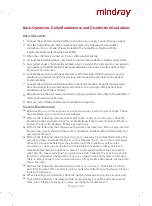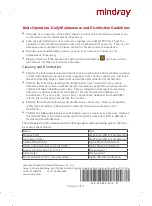
1.
Connect the ventilator and humidifier to the AC power supply. Connect the gas supply.
2.
Start the humidifier and set the relevant parameters by following the humidifier
instructions for use (check if the water level of the humidifier complies with the
requirement before starting the humidifier).
3.
When the ventilator is turned on, it runs self-test automatically.
4.
Connect the breathing tubes, and select to run (recommended) or skipthe system check.
5.
Once system check is finished, the ventilator starts to work in the set mode. For new patients,
you need to set the IBW, Patient Type (adult, pediatric or neonate), Gender, and Vent Type
(invasive or non-invasive).
6.
Connect the test lung, and check the status of the test lung. If the test lung is in good
condition, you can disconnect the test lung and connect the ventilator to the patient
(recommended).
7.
Connect the patient and breathing tubes, and start ventilation. Keep the patient under
close monitoring for a period and pay attention to the vital signs of the patient and
ventilation status of the ventilator.
8.
Keep observing the parameters and alarms during ventilation. Reconfigure the ventilation
mode or parameters if necessary.
9.
After use, turn off the ventilator and humidifier in sequence.
Basic Operation:
Routine Maintenance:
y
Before each use or after continuous use of two weeks, perform system check. Check
the breathing system resistance and leakage.
y
Perform the following maintenance several times a day or as necessary: check the
breathing tubes and water traps for water build-up. Empty water build-up if there is.
Inspect the parts for damage. Replace as necessary.
y
Perform the following maintenance each patient or as necessary: Perform pressure and
flow zeroing, system check and flow sensor calibration. Replace with disinfected parts or
new disposable parts.
y
Perform the following maintenance daily or as necessary (recommended):Clean the
external surfaces and calibrate the O
2
sensor.
Replace the O
2
sensor if it is damaged.
When the patient’s exhaled gas may contaminate the inspiratory safety valve
assembly, it is necessary to replace with disinfected inspiratory safety valve and
membrane.
Replace the expiration valve if it is damaged.Calibrate the CO
2
module
when the CO
2
measured value has a great deviation. Calibrate the touch screen if its
function is degraded. Check water traps at air supply inlet. Empty water build-up if
there is. Please contact your service personnel if any cracks and leakage are found on
the water traps.
y
Perform the following maintenance monthly or as necessary: Check the air intake
dust filter, fan dust filter and main unit air outlet dust filter for dust build-up. Clean or
replace as necessary.
y
When cleaning or installation, check the parts for damage and replace as necessary.
y
Check lithium battery charging and discharging every 6 months and replace every
three years. Please contact
your service personnel
for replacement.
Basic Operation, Daily Maintenance and Disinfection Guidelines
-Page 3 of 4-






















